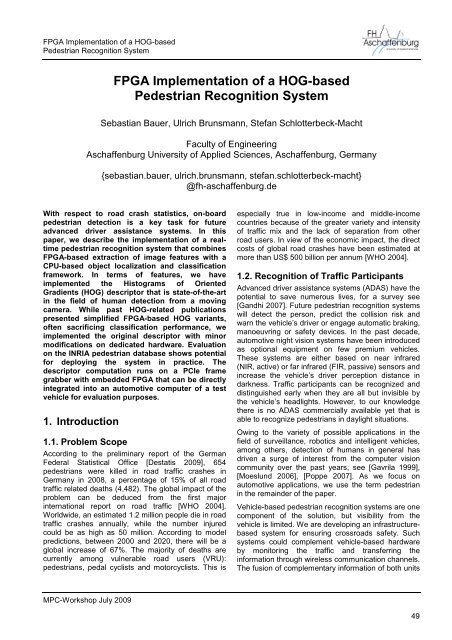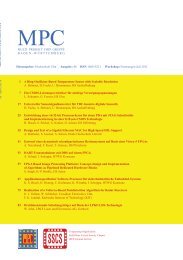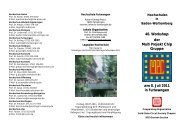Der UMC 0.18 Design Flow am Beispiel eines PDA ... - Mpc.belwue.de
Der UMC 0.18 Design Flow am Beispiel eines PDA ... - Mpc.belwue.de
Der UMC 0.18 Design Flow am Beispiel eines PDA ... - Mpc.belwue.de
Sie wollen auch ein ePaper? Erhöhen Sie die Reichweite Ihrer Titel.
YUMPU macht aus Druck-PDFs automatisch weboptimierte ePaper, die Google liebt.
FPGA Implementation of a HOG-based<br />
Pe<strong>de</strong>strian Recognition System<br />
FPGA Implementation of a HOG-based<br />
Pe<strong>de</strong>strian Recognition System<br />
Sebastian Bauer, Ulrich Brunsmann, Stefan Schlotterbeck-Macht<br />
Faculty of Engineering<br />
Aschaffenburg University of Applied Sciences, Aschaffenburg, Germany<br />
{sebastian.bauer, ulrich.brunsmann, stefan.schlotterbeck-macht}<br />
@fh-aschaffenburg.<strong>de</strong><br />
With respect to road crash statistics, on-board<br />
pe<strong>de</strong>strian <strong>de</strong>tection is a key task for future<br />
advanced driver assistance systems. In this<br />
paper, we <strong>de</strong>scribe the implementation of a realtime<br />
pe<strong>de</strong>strian recognition system that combines<br />
FPGA-based extraction of image features with a<br />
CPU-based object localization and classification<br />
fr<strong>am</strong>ework. In terms of features, we have<br />
implemented the Histogr<strong>am</strong>s of Oriented<br />
Gradients (HOG) <strong>de</strong>scriptor that is state-of-the-art<br />
in the field of human <strong>de</strong>tection from a moving<br />
c<strong>am</strong>era. While past HOG-related publications<br />
presented simplified FPGA-based HOG variants,<br />
often sacrificing classification performance, we<br />
implemented the original <strong>de</strong>scriptor with minor<br />
modifications on <strong>de</strong>dicated hardware. Evaluation<br />
on the INRIA pe<strong>de</strong>strian database shows potential<br />
for <strong>de</strong>ploying the system in practice. The<br />
<strong>de</strong>scriptor computation runs on a PCIe fr<strong>am</strong>e<br />
grabber with embed<strong>de</strong>d FPGA that can be directly<br />
integrated into an automotive computer of a test<br />
vehicle for evaluation purposes.<br />
1. Introduction<br />
1.1. Problem Scope<br />
According to the preliminary report of the German<br />
Fe<strong>de</strong>ral Statistical Office [Destatis 2009], 654<br />
pe<strong>de</strong>strians were killed in road traffic crashes in<br />
Germany in 2008, a percentage of 15% of all road<br />
traffic related <strong>de</strong>aths (4,482). The global impact of the<br />
problem can be <strong>de</strong>duced from the first major<br />
international report on road traffic [WHO 2004].<br />
Worldwi<strong>de</strong>, an estimated 1.2 million people die in road<br />
traffic crashes annually, while the number injured<br />
could be as high as 50 million. According to mo<strong>de</strong>l<br />
predictions, between 2000 and 2020, there will be a<br />
global increase of 67%. The majority of <strong>de</strong>aths are<br />
currently <strong>am</strong>ong vulnerable road users (VRU):<br />
pe<strong>de</strong>strians, pedal cyclists and motorcyclists. This is<br />
especially true in low-income and middle-income<br />
countries because of the greater variety and intensity<br />
of traffic mix and the lack of separation from other<br />
road users. In view of the economic impact, the direct<br />
costs of global road crashes have been estimated at<br />
more than US$ 500 billion per annum [WHO 2004].<br />
1.2. Recognition of Traffic Participants<br />
Advanced driver assistance systems (ADAS) have the<br />
potential to save numerous lives, for a survey see<br />
[Gandhi 2007]. Future pe<strong>de</strong>strian recognition systems<br />
will <strong>de</strong>tect the person, predict the collision risk and<br />
warn the vehicle’s driver or engage automatic braking,<br />
manoeuvring or safety <strong>de</strong>vices. In the past <strong>de</strong>ca<strong>de</strong>,<br />
automotive night vision systems have been introduced<br />
as optional equipment on few premium vehicles.<br />
These systems are either based on near infrared<br />
(NIR, active) or far infrared (FIR, passive) sensors and<br />
increase the vehicle’s driver perception distance in<br />
darkness. Traffic participants can be recognized and<br />
distinguished early when they are all but invisible by<br />
the vehicle’s headlights. However, to our knowledge<br />
there is no ADAS commercially available yet that is<br />
able to recognize pe<strong>de</strong>strians in daylight situations.<br />
Owing to the variety of possible applications in the<br />
field of surveillance, robotics and intelligent vehicles,<br />
<strong>am</strong>ong others, <strong>de</strong>tection of humans in general has<br />
driven a surge of interest from the computer vision<br />
community over the past years, see [Gavrila 1999],<br />
[Moeslund 2006], [Poppe 2007]. As we focus on<br />
automotive applications, we use the term pe<strong>de</strong>strian<br />
in the remain<strong>de</strong>r of the paper.<br />
Vehicle-based pe<strong>de</strong>strian recognition systems are one<br />
component of the solution, but visibility from the<br />
vehicle is limited. We are <strong>de</strong>veloping an infrastructurebased<br />
system for ensuring crossroads safety. Such<br />
systems could complement vehicle-based hardware<br />
by monitoring the traffic and transferring the<br />
information through wireless communication channels.<br />
The fusion of complementary information of both units<br />
MPC-Workshop July 2009<br />
49





![[Geben Sie hier die Überschrift ein] - MPC](https://img.yumpu.com/8654082/1/188x260/geben-sie-hier-die-uberschrift-ein-mpc.jpg?quality=85)




